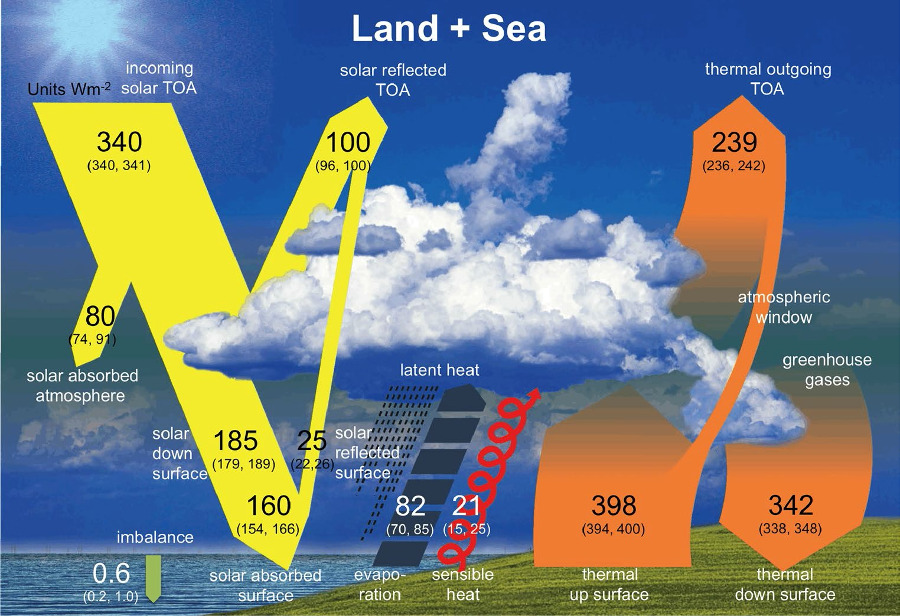Revaluation of the Global Energy Balance

Despite its central importance for the climate system and climate change, substantial uncertainties still exist in the quantification of the components of the Global Energy Balance, and their representation in climate models (e.g., Wild et al. 1998, 2013, 2015, 2018; Wild 2008, 2017). While the net radiative energy flows in and out of the climate system at the top of atmosphere (TOA) are now known with considerable accuracy from new satellite programs such as CERES and SORCE, a challenge remains the energy distribution within the climate system. Specifically, still not well established is the partitioning of solar energy absorption between the atmosphere and surface, and within the atmosphere between cloudy and cloud-free parts, as well as the determination of the thermal energy exchanges at the surface/atmosphere interface (Wild 2012). Uncertainties in the components of the global mean surface radiation budget are therefore generally larger and less well quantified than at the TOA. Since the mid-1990s, accurate direct measurements become increasingly available from the networks of surface radiation stations, such as the Baseline Surface Radiation Network (BSRN), which can serve as reference sites. For IPCC AR5 we established best estimates of the global mean values of the different components of the global energy balance, making full use of the information contained in direct surface radiation observations in combination with satellite observations and modeling approaches (Wild et al. 2013). Attempts have also been made to estimate the energy balance separately over land and oceans (Wild et al. 2015), as well as the global energy balance under cloud-free conditions (Wild et al. 2018). Further, combining collocated solar radiation observations from surface and space allows the estimation of absorption of solar radiaton within the atmospheric column at European and worldwide sites (Hakuba et al. 2014b, Schwarz et al. in preparation). The combination of surface point observations with collocated gridded satellite products requires a priori a detailed assessment of the representativeness of the surface station for its larger scale setting (Hakuba et al. 2013, 2014a, Schwarz et al. 2017, 2018)
Wild, M., and Co-authors 1998: The disposition of radiative energy in the global climate system: GCM-calculated versus observational estimates. Climate Dynamics, 14, 853-869.
Wild, M., 2008: Short-wave and long-wave surface radiation budgets in GCMs: a review based on the IPCC-AR4/CMIP3 models. Tellus A, 60, 932-945.
Wild, M., 2012: New Directions: A facelift for the picture of the global energy balance. Atmospheric Environment, 55, 366-367.
Wild, M., and Co-authors 2013: The global energy balance from a surface perspective. Climate Dynamics, 40, 3107-3134.
Hakuba, M.Z., Folini, D., Sanchez-Lorenzo, A., and Wild, M. 2013: Spatial representativeness of ground-based solar radiation measurements, J. Geophys. Res., 118, 8585–8597, doi:10.1002/jgrd.50673.
Hakuba, M.Z., Folini, D., Sanchez-Lorenzo, A., and Wild, M. 2014a: Spatial representativeness of ground-based solar radiation measurements - Extension to the full Meteosat disk. J. Geophys. Res. Atmos., 119, 11,760–11,771, doi:10.1002/2014JD021946.
Hakuba, M.Z., Folini, D., Schaepman-Strub, G., and Wild, M., 2014b: Solar Absorption over Europe from collocated surface and satellite observations, J. Geophys. Res., 119, 3420-3437, DOI: 10.1002/2013JD021421.
Wild, M., and Co-authors 2015: The energy balance over land and oceans: An assessment based on direct observations and CMIP5 climate models, Climate Dynamics, 44, 3393–3429, DOI: 10.1007/s00382-014-2430-z.
Wild, M., 2017: Towards Global Estimates of the Surface Energy Budget, Curr. Clim. Change Rep, 3, 87–97. DOI: 10.1007/s40641-017-0058-x
Schwarz, M., Folini, D., Hakuba, M.Z., and Wild, M., 2017: Spatial Representativeness of Surface-Measured Variations of Downward Solar Radiation, J. Geophys. Res., 122, 13319-13337, DOI: 10.1002/2017JD027261.
Schwarz, M., Folini, D., Hakuba, M.Z., and Wild, M., 2018: From point to area: worldwide assessment of the representativeness of monthly surface solar radiation records, J. Geophys. Res., under review.
